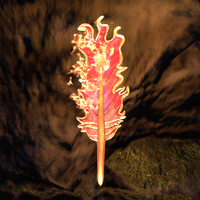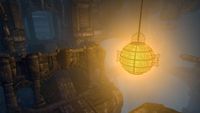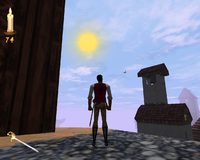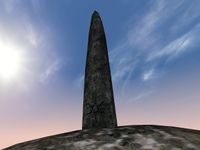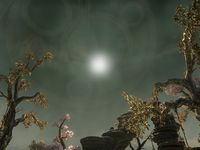Lore:Sun
The sun (also known as Magnus, Daibethe in Yoku, and Vakka in Jel)[1][2][3] is the common term for the largest tear in reality between the Mundus and Aetherius, and appears as a bright orb in the skies of Nirn. It is the main source of magicka in the world which flows constantly from Aetherius.[4]
The common story for its creation is that is formed when the Aedra Magnus fled the mortal world in the final stages of its creation, to prevent himself being trapped.[5] He was joined by the Magna Ge, who left similar but smaller "holes" which became known as the stars.[6][5][7][8] In the Anuadic creation story, prior to the shattering of the twelve worlds and the formation of Nirn, Anu in his grief at the loss of Nir, hid himself in the sun and slept.[9]
Sunlight is necessary for surface plantlife to grow.[10] In locations which lack natural sunlight, such as the Clockwork City, biological plantlife will not thrive unless the lifegiving properties of Nirn's sun can be simulated successfully.[11] This was discovered by the Clockwork Apostles from the Everwound Wellspring, and to produce viable amounts for a harvest, the life force of beings would be required to simulate on a small scale what the Sun produces naturally.[11][12]
However, despite the lifegiving properties of the sun, health issues can occur due to overexposure. This is colloquially known as sunburn or "Aetherial exposure", various alchemical concoctions can be used to lessen the effects.[13] For vampires, Aetherial exposure has more extreme effects, as most of the vampire breeds will burn when they enter direct sunlight.[14]
The 1st day of Midyear is considered the hottest day of the year.[2]
Contents
Cultural Interpretations[edit]
Altmer[edit]
The Sun Birds of Alinor were Altmer of the Merethic Era who were known to have traveled to Aetherius in ships called sunbirds.[15] Sunbirds have been described as being made of crystal and solidified sunlight; having gem-encrusted mini-trebuchets, fit for sailing, that fire pure aetheric fire; and having banners listing their ancestors all the way back to the Dawn.[UOL 1]
One of the Summerset Isles' major cities is Sunhold on the south coast of the main island.[16] The city's symbol is a yellow sun with a red outline on a white background.[17] The way the sun sets over the southeastern mountains and covers the coast in shadows is how the city of Dusk acquired its name.[18]
Three is one of the Sacred Numbers, which the Altmer recognize as integral to the universe's existence. Three, in particular, represents the Prime Celestials, which are embodied by the Sun and the two moons.[19]
Argonian[edit]
Marsh-born Argonians enjoy basking in the sun.[20] Contrary to what some foreign scholars believe, Argonians do not worship the sun. Rather, they enjoy its warmth[21] and bask in its light.[22] Argonian ladies may carry a parasol to keep their scales from drying out in the hot sun.[23] Reclusive Argonians that live in places away from sunlight (such as subterranean caverns) will lose the color in their scales.[24]
Vakka Stones (literally "Sun Stones" in the Jel language)[3] are bright yellow crystals used by the ancient Argonians to store the raw magicka that falls from the sun.[25]
Prior to Duskfall, some tribes of ancient Argonians were directed by their Hist tree to worship the sun or even to collect its power.[26] Known as the Sun-Blessed, they were eventually betrayed by their Sithis-worshippping brethren, and the practice faded into obscurity.[27][28]
Another myth associated with the pre-Duskfall Argonians, is of a tribe of golden-scaled Argonians that built their city upwards to reach the sun. However the ending of the story can differ, with one version claiming the sun destroyed them, while another says the tribe cracked the sun open "like an egg" and became gods.[29]
Breton[edit]
The Priory of the Golden Staff were peaceful followers of Magnus headquartered near Stormhaven,[30] teaching of Magnus's grand design for the Mundus, and his disappointment at the flaws introduced into his creation. According to them Magnus watches from the sun, waiting to repair what the others set amiss.[31][32] Nynelle Dumaris, a famous Breton poet authored a poem Fearless as the Sun.[33]
Dunmer[edit]
Morrowind legends, specifically from Vivec’s famous sermons claim that Nerevar was banished from the library of the sun by the power of Magnus.[34]
Dwemer[edit]
According to scholars studying Dwarven lore, the Dwemer paid tribute to the sun in form of the "Solar Arc" iconography. Some of their animunculi were surmounted with double golden crescents representing the sun. It was a rare occurrence, however.[35] As they often lived underground, they created large "miniature suns" to light the dark caves.[36]
Khajiit[edit]
The oppressive climate of Elsweyr makes it impractical to wear heavy clothing and armor. The typical bipedal Khajiit dresses in an ample shawl of brightly-colored cloth, known as a budi, for defense against the harsh rays of the sun. This shirt is tightly fastened in braids down the right side, to prevent any part of the torso fur from being seen, as the exposure of such in public is deemed both offensive and unsightly.[37]
In Khajiit religion Magrus is known as the Sun God or the Cat's Eye. And like his counterpart, he is also associated with magic, and is revered by some Khajiit magi. However, there are several versions of Magrus' association with the sun.[38] In the works of Clan Mother Ahnissi, Magrus is given his authority over the Sun by Ahnurr.[39] However, this is elaborated on in earlier stories which predate the religious reforms of the Riddle'Thar Epiphany and is where his other title, the Third Eye of Azurah originates. In these tales, Magrus had been blinded in one eye while being pursued by Boethra and Lorkhaj and then fell into the Oblivion realm Moonshadow. Here Azurah found and judged him, in the versions more sympathetic to Magrus, he willingly sacrifices his eye to Azurah for the benefit of the Khajiit. In the other known version, Azurah deems him as too afraid to have authority over a sphere and takes his second eye and Magrus is left blinded.[38]
Azurah was then said to have turned the eye into a stone known as the Aether Prism, which would reflect the Varliance Gate. This story is used to explain sunrise and sunset on Nirn, where it is said to be the daily opening and closing of the Aether Prism.[38]
The Sunspire is a holy temple dedicated to the Dragon God of Cats, Alkosh. It is located on the southern edge of Anequina, near the Tenmar Forest and it is where the deity fought Pelinal Whitestrake.[40][41] Creatures known as Solar Horses are said to be associated with Magrus.[42] The Khajiit in the Third Era would sometimes use the exclamation, "Desert Sun".[43]
Nede[edit]
The council of kings under High King Durac of Skyreach, among seven other titles, had a Sun King. These kings served as representative leaders of the various tribes under Skyreach's jurisdiction.[44][45] The Nedes of Cyrodiil also held significance in the sun, feeling dismayed on the fifth of First Seed, 1E 393, when the sun darkened. They predicted a great event would occur after, which was proven correct within the year when the Ayleids of Malada emerged from their fane and afflicted the local farmland.[46]
Nord[edit]
Ancient Nords used glass-like sunstones to determine the sun's location even on a cloudy day. Ysgramor was said to use one such device during his voyages.[47] Dawnstar's name is inspired by the sun as it rises over the town at the beginning of the day.[48] In southern Skyrim, there is a stronghold on a plateau called Fort Sungard and it protects the road between the Reach and central Skyrim.[49]
Orc[edit]
The practice known as the death of sun and feathers was a form of execution practiced by the Iron Orcs. The sentenced was nailed to the stone and cut once for each of the ten iron oaths and then the sun burned until the crows gather. It was considered a proper death for liars and traitors.[50][51]
Redguard[edit]
The Redguards refer to the sun as Daibethe. On the 1st of Midyear, the people of Abibon-Gora honor it through the festival of Drigh R'Zimb.[2] The Redguard spirit of the air, Tava is often associated with elements of the sun[52] and factions in reverence to her such as the Glinting Talons used references to the sun and light frequently.[53] The Redguards in the Third Era would sometimes use the exclamation, "by the Sun".[54]
The Pillar of the Singing Sun is a cenotaph dedicated to Frandar Hunding. It is built on a small island in Stros M'Kai, specifically west of the Ogres Tooth Mountains.[55][56] The town of Sunkeep is located on the western coast between Hegathe and Sentinel.[57]
Reachfolk[edit]
According to the Reachfolk legends every new year in the vale of Karth as autumn wanes the wolf aspect of Hircine, the Storihbeg pursues the sun in an attempt to devour the orb and prevent the coming of the New Life. Reachfolk Shamans perform the ritual to summon the great Hrokkibeg to interpose his might to drive the beast off and shorten the night. They believe that those who hate the sunlight dance rites to hinder the return of Magnus, but their attempts are doomed to fail.[UOL 2]
Skaal[edit]
The six All-Maker Stones of Solstheim are viewed as representations of the six aspects of nature, the six great gifts of the All-Maker—flora, fauna, the sun, the earth, water, and wind. The stones are believed to be conduits by which the All-Maker's power flows into the world.[58][59][60]
Artifacts[edit]
Auriel's Bow[edit]
Auriel's Bow, (also spelled Auri-El's Bow) is an artifact used by the elven god Auriel. Although it takes the form of a modest elven moonstone bow, it is one of the most powerful weapons on Tamriel.
The bow draws its power from Aetherius itself, channeling it through the sun. It has the ability to turn any arrow into a "missile of death", although its enchantment effects vary: it has been known to cause magical fire or shock damage, drain an opponent's stamina and magicka reserves, or harness the power of the sun. It can also make the wielder immune to lesser attacks, and is especially devastating when used against the undead. Occasionally it can be seemingly unenchanted. Without Auriel's power behind it, however, the bow uses its own store of energy for its power. Once exhausted of this energy, the bow will vanish, abandoning its owner to reappear elsewhere.
Gallery[edit]
Notes[edit]
- "The jacinth wakes the rising sun" is a riddle of an obscure alchemical formula[61] that can provide access to the Fields of Regret, the domain of Clavicus Vile. The "Rising Sun" refers to Orc's blood and the "Jacinth" is Amber.[62][63] The master conjurer, Morian Zenas labels the complete process a Door of Oblivion.[61]
See Also[edit]
References[edit]
- ^ Spread Holiday Cheer During The New Life Festival on the official ESO website
- ^ a b c Drigh R'Zimb holiday description in Daggerfall
- ^ a b The Sharper Tongue: A Jel Primer — Lights-the-Way, Mystic of the Mages Guild
- ^ Pocket Guide to the Empire, 3rd Edition: Arena Supermundus: The Tapestry of Heaven — Imperial Geographical Society, 3E 432
- ^ a b The Monomyth
- ^ Exegesis of Merid-Nunda — Phrastus of Elinhir
- ^ Varieties of Faith in the Empire — Brother Mikhael Karkuxor of the Imperial College
- ^ 36 Lessons of Vivec, Sermon 33 — Vivec
- ^ The Annotated Anuad
- ^ Naril's Note: Simulated Sunlight — Lector Naril
- ^ a b Naril's Note: Success Out of Tragedy — Lector Naril
- ^ Events from Oasis in a Metal Desert in ESO: Clockwork City
- ^ Jar of Sun Cream item description in ESO
- ^ Orb of Magnus item description from ESO
- ^ Pocket Guide to the Empire, 3rd Edition: Arena Supermundus: The Tapestry of Heaven — Imperial Geographical Society, 3E 432
- ^ Map of the Summerset Isles – The Elder Scrolls Anthology
- ^ Banner of Sunhold – The Elder Scrolls Online
- ^ ESO Summerfall Event Special Livestream
- ^ Thoughts on the Sacred Numbers
- ^ Runs-in-Wild's dialogue after helping Captain Rana at the docks during Breaking the Tide in ESO
- ^ Plays-In-Puddles' dialogue in ESO: Dark Brotherhood
- ^ The Sharper Tongue: A Jel Primer — Lights-the-Way, Mystic of the Mages Guild
- ^ Panther Skin Sun Parasol item description in ESO
- ^ Marshmist Palescale skin description in ESO
- ^ Kassandra's dialogue during Whispers in the Wood in ESO: Murkmire
- ^ Vakka-Bok Xanmeer in ESO
- ^ In Accord With Those Sun-Blessed — Solis Aduro
- ^ The Last Wish of the Sun-Blessed — Solis Aduro
- ^ Lost Tales of the Famed Explorer: Fragment II — Solis Aduro
- ^ Meet the Character - Sister Celdina — Captain Rian Liore
- ^ Doombringer Celdina's Testament — Doombringer Celdina
- ^ Sister Celdina's dialogue in ESO: The Deadlands
- ^ Fearless as the Sun — Nynelle Dumaris, Poet of Galen
- ^ The 36 Lessons of Vivec — Vivec
- ^ Solar Arc Dwarven Spider's description in ESO
- ^ Miniature Dwarven Sun memento
- ^ Pocket Guide to the Empire, 1st Edition: The Elsweyr Confederacy — Imperial Geographical Society, 2E 864
- ^ a b c The Sky Spirits — Amun-dro, the Silent Priest
- ^ Words of Clan Mother Ahnissi — Clan Mother Ahnissi
- ^ Sunspire in ESO: Elsweyr
- ^ Moon-Bishop Azin-jo's dialogue in ESO: Elsweyr
- ^ Description of Dragonscale Solar Horse in ESO
- ^ Khajiit in Daggerfall
- ^ Saradin's Diary — Saradin
- ^ The Sun King's appearance in ESO
- ^ Cleansing of the Fane
- ^ High King Sunstone antiquity codex entries in ESO: Greymoor
- ^ Dawnstar location and rumors in Arena
- ^ Fort Sungard in Skyrim
- ^ Agganor's Journal — Shaman Agganor
- ^ Lashburr Tooth-Breaker's dialogue in ESO
- ^ The Unveiled Azadiyeh Answers Your Questions — The Unveiled Azadiyeh
- ^ Glinting Talons — Ablahar at-Tanul
- ^ Redguard in Daggerfall
- ^ A Fortune Behind Those Walls
- ^ Pillar of the Singing Sun in ESO
- ^ Sunkeep in Arena
- ^ Storn Crag-Strider's dialogue in Skyrim: Dragonborn
- ^ Korst Wind-Eye's dialogue in Morrowind: Bloodmoon: Morrowind
- ^ Frea's dialogue Skyrim: Dragonborn
- ^ a b The Doors of Oblivion — Seif-ij Hidja
- ^ Rescue Iszara story quest in Redguard
- ^ N'Gasta's Spellbook — N'Gasta
Note: The following references are considered to be unofficial sources. They are included to round off this article and may not be authoritative or conclusive.

